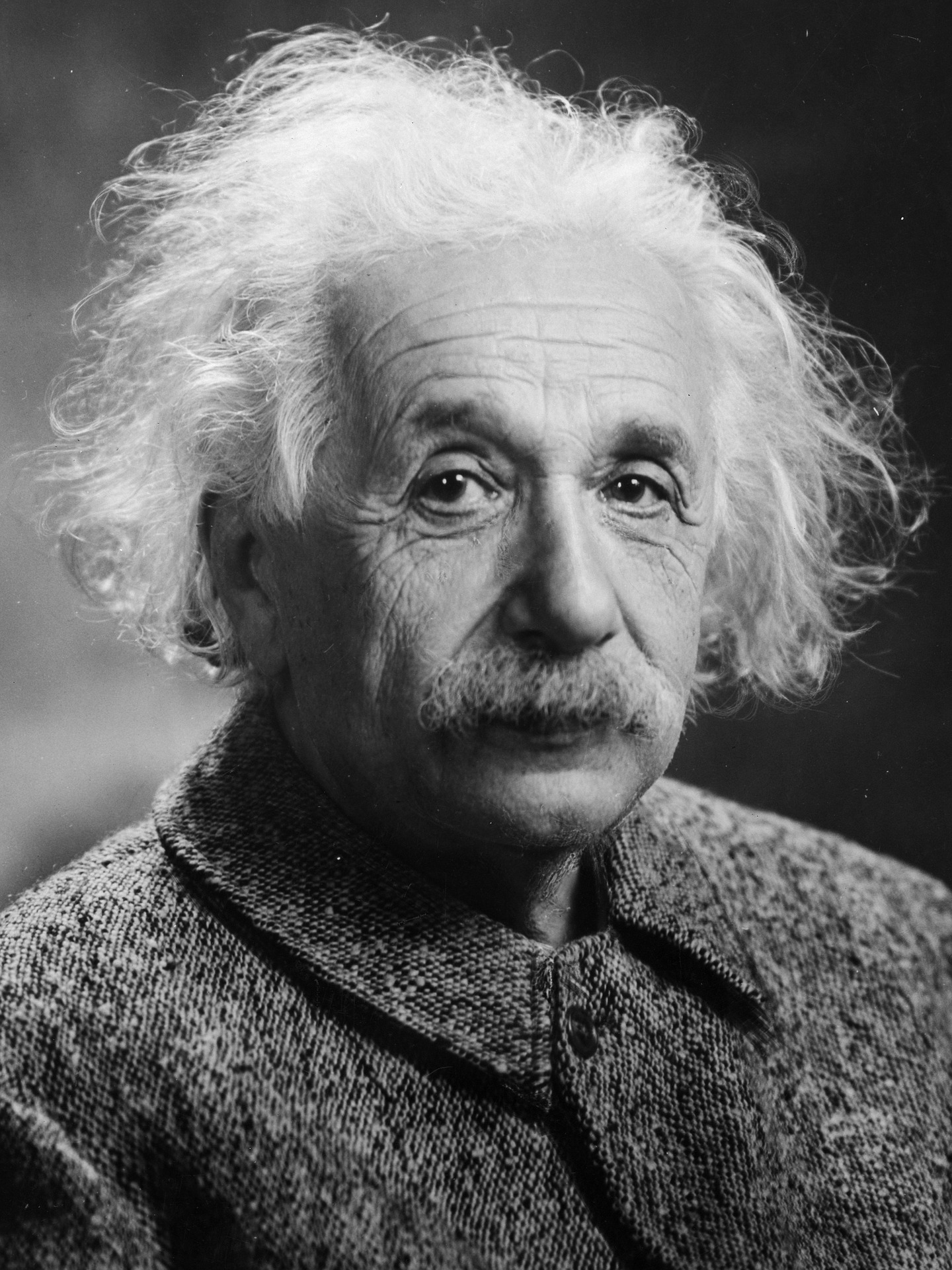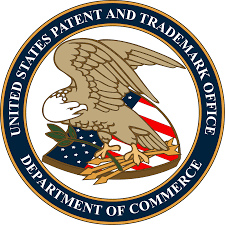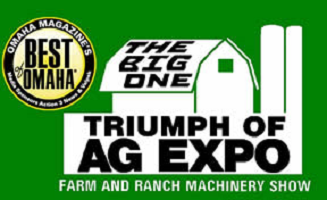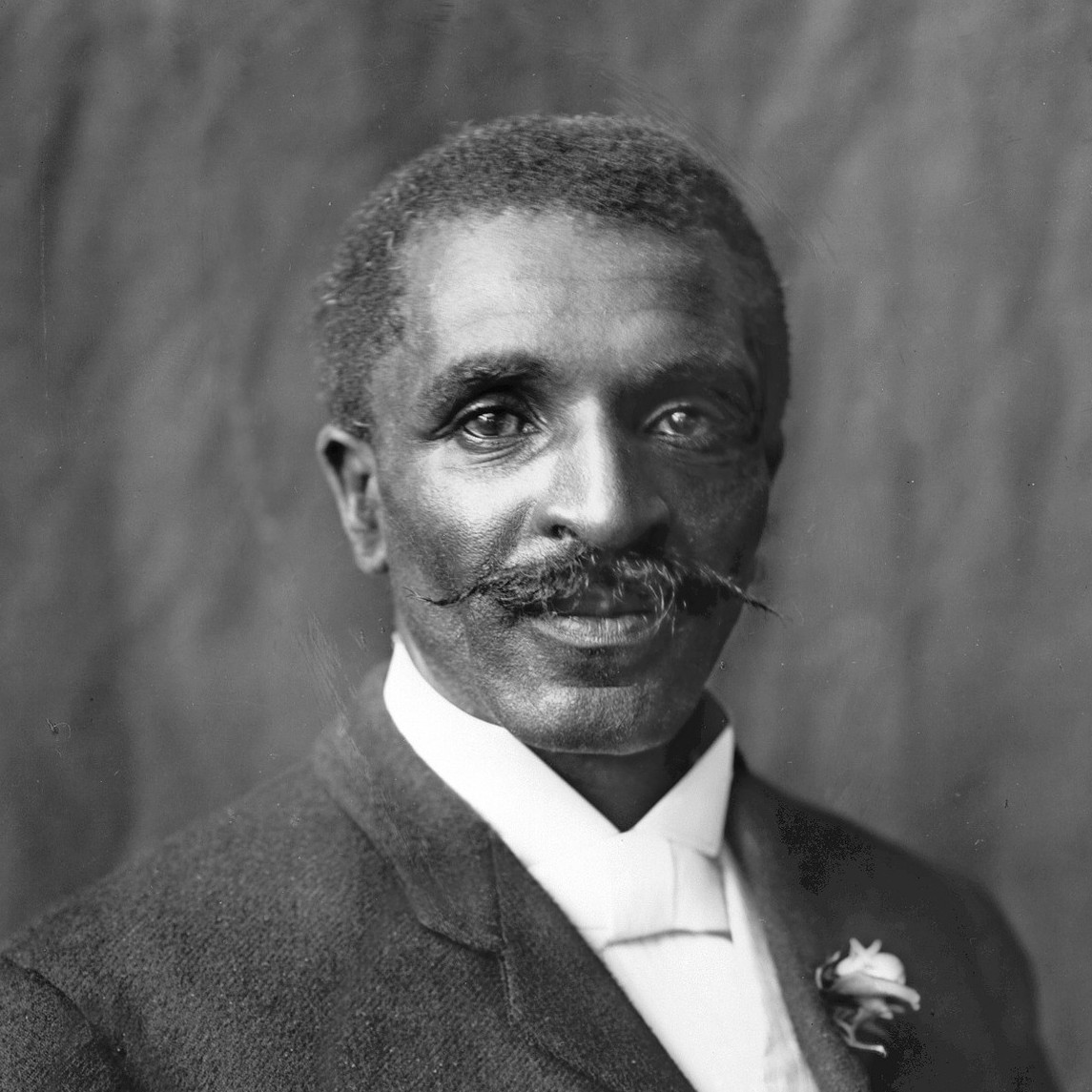Happy Birthday Einstein
Albert Einstein was born on March 14, 1879, in Ulm, Württemberg Germany. In addition to his work related to general and special relativity, Brownian motion, and the photoelectric effect (for which he won the 1921 Nobel Prize), Einstein spent 1902-1909 as a patent clerk in the Swiss Patent Office. Although many might dismiss Einstein’s time at the Swiss Patent Office as unimportant, this period may have resulted in the biggest contribution to physics by an individual in human history.
It was during his tenure at the patent office that Einstein had his “annus mirabillis,” or miracle year. In 1905, Einstein crafted his four significant theoretical works:
- “Heuristic Viewpoint Concerning the Production and Transformation of Light” (i.e., The Photoelectric Effect)
- “On the Motion of Small Particles Suspended in a Stationary Liquid, as Required by the Molecular Kinetic Theory of Heat” (i.e., Brownian Motion)
- “On the Electrodynamics of Moving Bodies” (i.e., Special Relativity)
- “Does the Inertia of a Body Depend Upon Its Energy Content?” (i.e., General Relativity)
Prior to his time at the Swiss Patent Office, Einstein failed the entrance exam to the University of Zurich and decided to move to Bern, Switzerland. After unsuccessfully applying for multiple teaching positions, a former classmate of Einstein recommended he consider a position at the Swiss Federal Office of Intellectual Property. Einstein enjoyed his time at patent office where he reviewed patents. He viewed this as good work with good pay, but the work was not intellectually stimulating to Einstein, which gave him ample free time to work on his scientific works. He referred to this time as “that worldly cloister where I hatched my most beautiful ideas.”
While it is not entirely clear what patent applications Einstein examined, it is known that he examined many applications related to electromagnetic and electromechanical technologies. Below is a listing of a few of the patent applications believed to have passed across Einstein’s desk. Enjoy!
Kiessortiermaschine (“Gravel Sorter”)
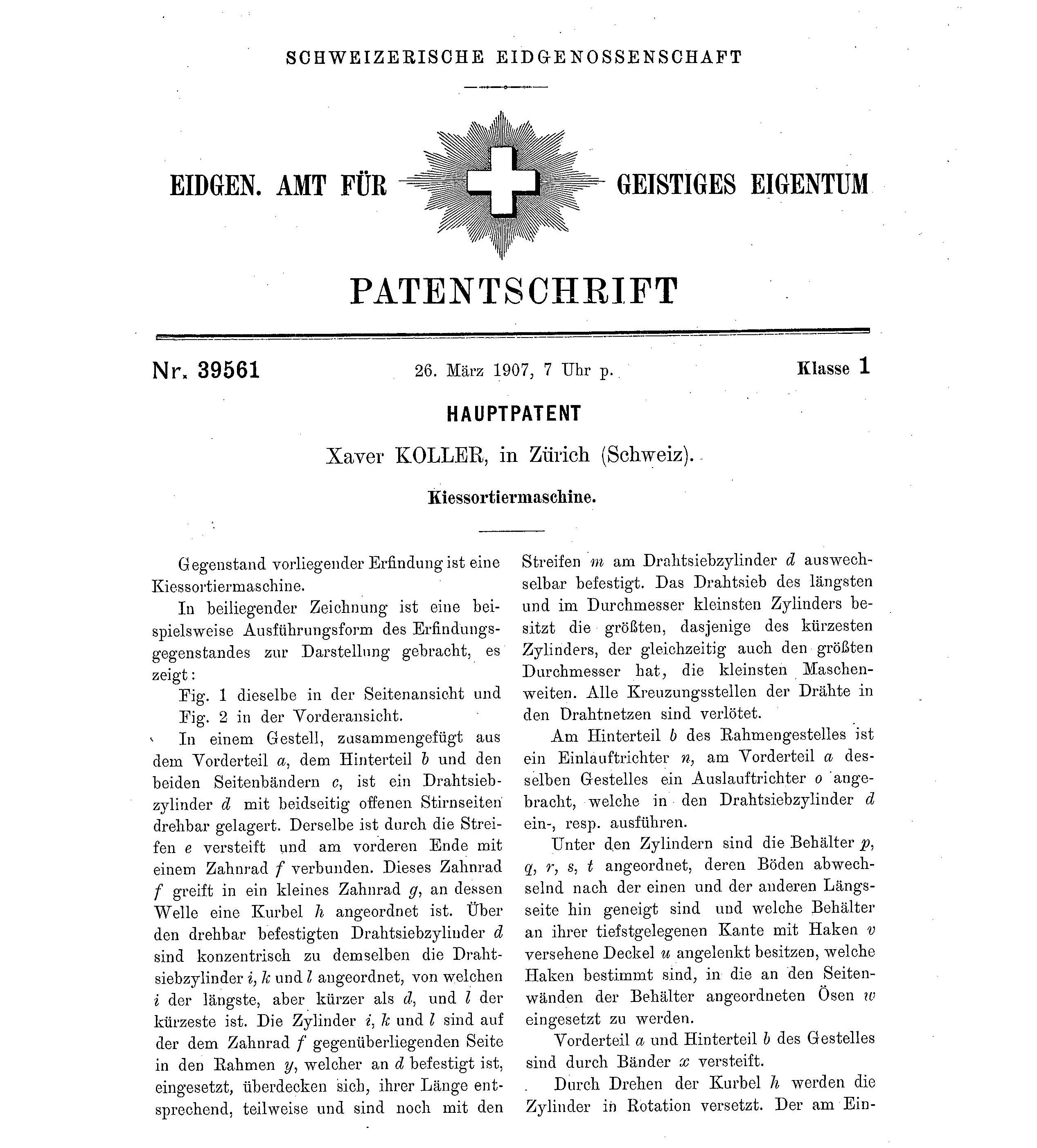
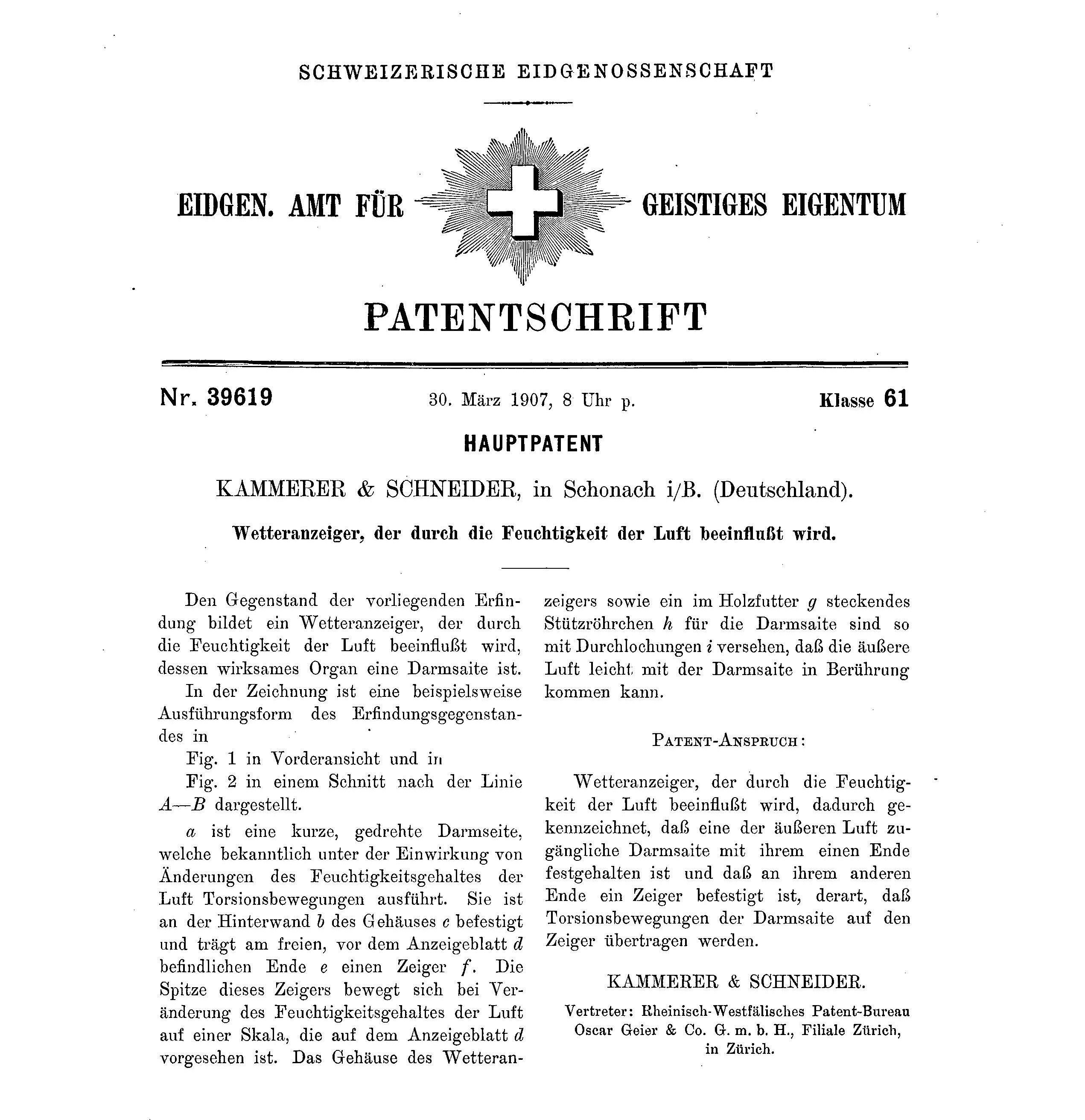
Elektrische typenschiffchen-schreibmaschine (“Electric Typewriter”)
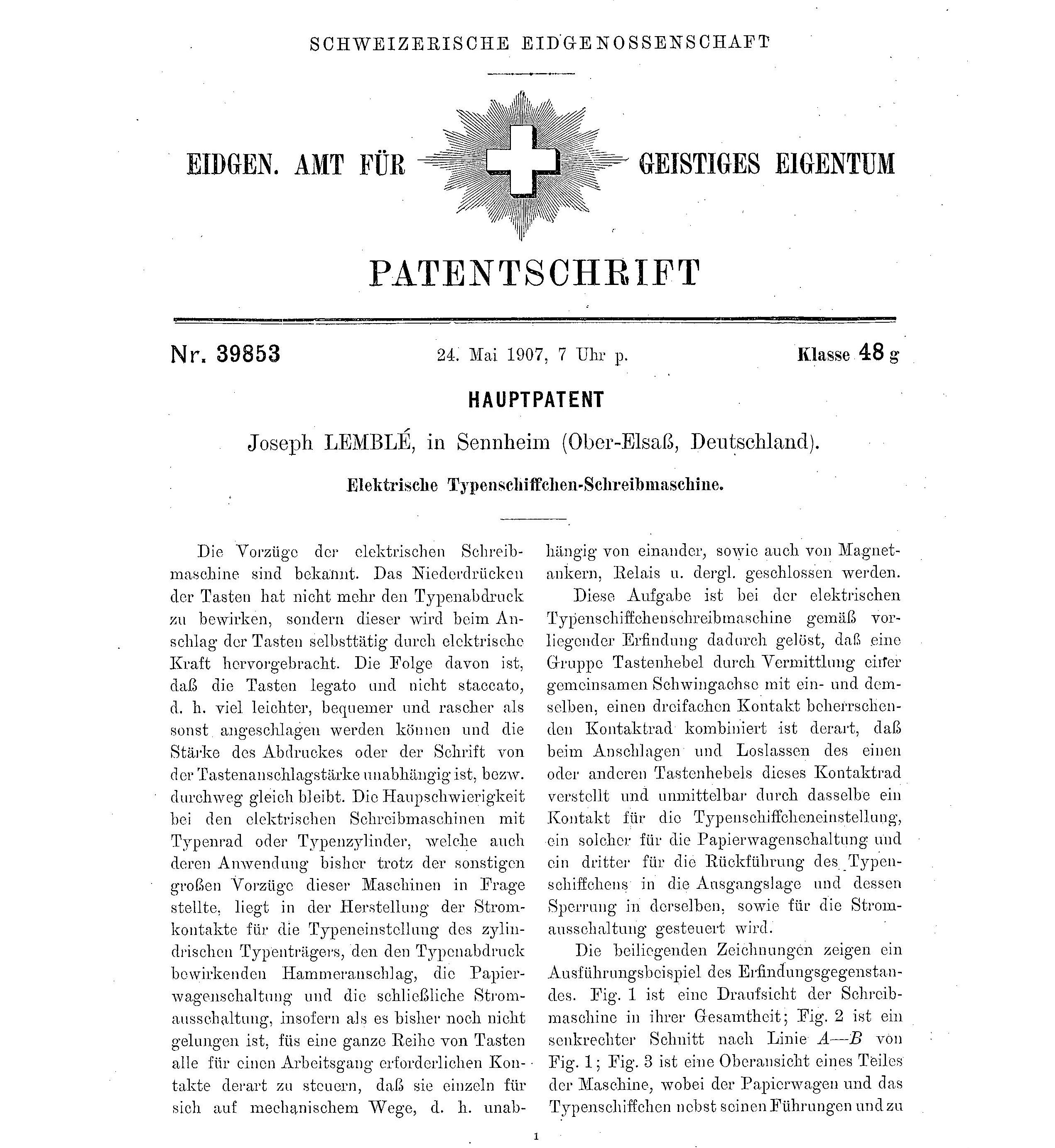
Suiter Swantz IP is a full-service intellectual property law firm, based in Omaha, NE, serving all of Nebraska, Iowa, and South Dakota. If you have any intellectual property questions or need assistance with any patent, trademark, or copyright matters and would like to speak with one of our patent attorneys please contact us.
Yes, "March Madness" is a Registered Trademark
March is in full swing. While some may be hoping for spring and warmer weather, others will be hoping their favorite college basketball team will get to cut down the nets at the NCAA Men’s College Basketball Tournament.
The tournament is big business for the National Collegiate Athletic Association (NCAA) generating roughly $900 million in revenue annually. With that much money at stake, it is not surprising that the NCAA would protect their investment and that includes their intellectual property. In fact, the NCAA’s website states use of their trademarks “are carefully controlled and aggressively protected.”
The NCAA currently owns the trademark for the term March Madness® but that was not always the case. The term March Madness® did not originate with the NCAA, it originated with Henry Porter, secretary for the Illinois High School Association (IHSA). In the 1939 edition of the IHSA magazine, Porter described a championship basketball game by saying “A little March madness may complement and contribute to sanity and keep society on an even keel.” By 1973 the IHSA had registered the trademark “March Madness” and “America’s Original March Madness” and began using the term on merchandise and programs.
In 1982, Brent Musburger was announcing a NCAA Tournament game and used the term March Madness to describe it. Musburger did not think anything of it, but the listening audience did and from there the term generated steam. The NCAA took notice of how popular it became and licensed it as a trademark.
Unfortunately, for the IHSA, they did not take immediate action against the NCAA and the NCAA continued to use the term and a heavy association was created between March Madness® and the NCAA basketball tournament.
In 1996, a video game developer tried to release a game that used the trademarked phrase on the case of the game, but this time the IHSA did not stand idly by. GTE Vantage, the video game developer, was met with a lawsuit. The Court ruled and found that the IHSA waited too long to take action and the term “March Madness” had been identified with both the NCAA and the IHSA. The Court further categorized the term as a dual-use term or “a name that the public has affixed to something other than, as well as, the Illinois high school basketball tournament.” In an effort to keep the trademark, the IHSA asked the NCAA to form a joint venture, the March Madness Athletic Association (MMAA).
This joint venture allowed the MMAA to actively police their intellectual property and send cease-and-desist letters to those who infringe on it. Around tournament time, those who have not paid to be an official licensee/sponsor of March Madness® should refer to it in other ways, but be careful as the NCAA also hold trademarks for the following: Selection Sunday®, the Elite Eight®, The Final Four®, The Big Dance®, and many more.
If planning a party for the college basketball tournament this year, think twice about what you call it. The NCAA will be watching and they send hundreds of cease-and-desist letters this time of year.
Suiter Swantz IP is a full-service intellectual property law firm, based in Omaha, NE, serving all of Nebraska, Iowa, and South Dakota. If you have any intellectual property questions or need assistance with any patent, trademark, or copyright matters and would like to speak with one of our patent attorneys please contact us.
Patent of the Week: Compact Hand-Held Video Game System (Gameboy)
On February 9, 1993, inventors, Satoru Okada and Shin Kojo were granted the patent for COMPACT HAND-HELD VIDEO GAME SYSTEM U.S. Patent No. 5,184,830. The assignee was Nintendo Company Limited.
This video game system is now known and referred to as the Gameboy®. According to the patent application the game system was “a hand-held electronic game machine for use with attachable/detachable memory game packs wherein the game machine includes a case of a size which may be held by a hand and capable of being sandwiched in both hands.”
This was the perfect machine for gaming enthusiasts who had been waiting for something that would allow them to play games on the go. Its size and shape made it easy to carry around and store, and its interchangeable game packs allowed the user to play multiple games.
The Gameboy® has evolved over time, color changes, thickness, etc., but for the most part it has retained its original look and feel.
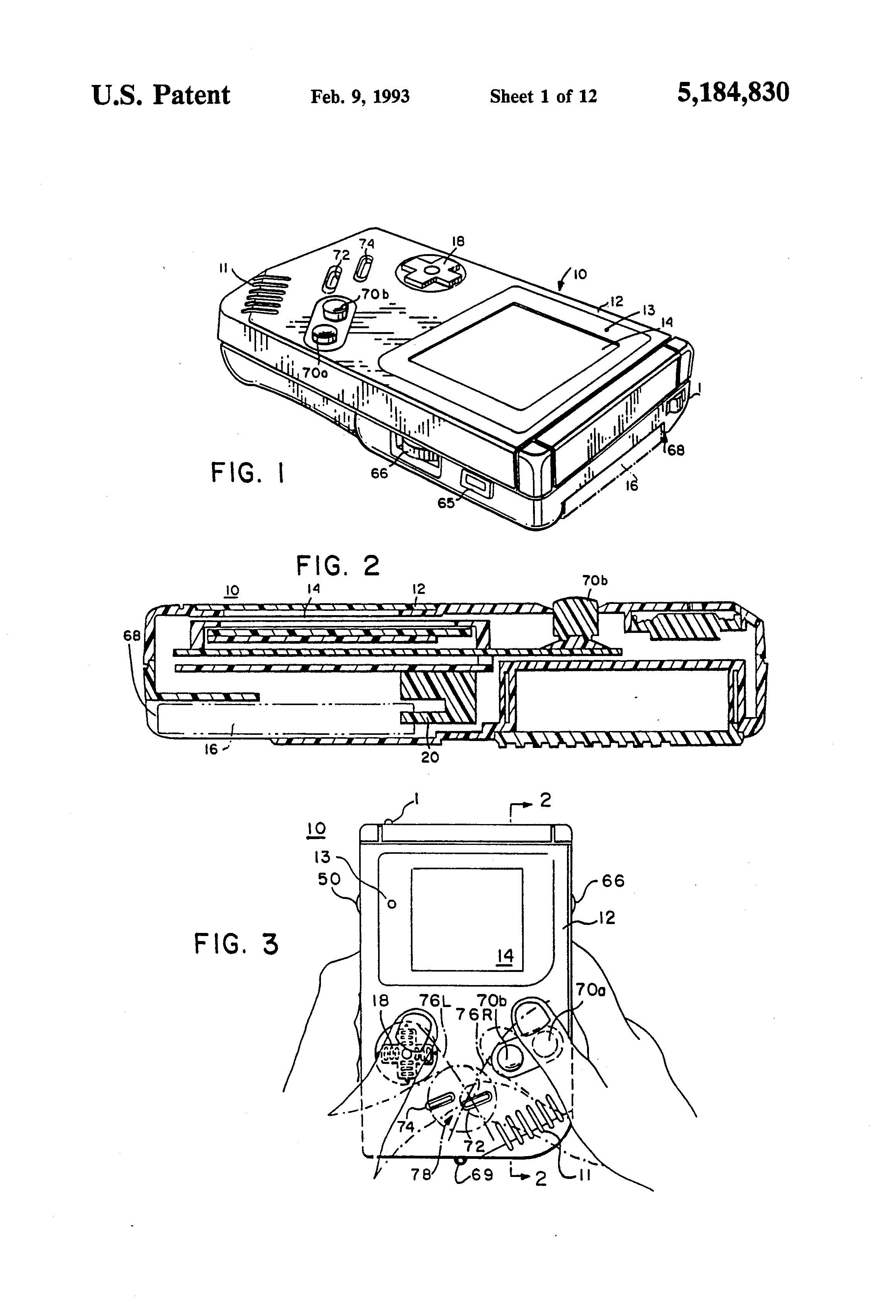
Suiter Swantz IP is a full-service intellectual property law firm, based in Omaha, NE, serving all of Nebraska, Iowa, and South Dakota. If you have any intellectual property questions or need assistance with any patent, trademark, or copyright matters and would like to speak with one of our patent attorneys please contact us.
USPTO to Announce New Patent Design and 10 Millionth Patent at SXSW
At this year’s South by Southwest (SXSW) event in Austin, Texas, the USPTO will announce the issuance of the 10 millionth patent. To commemorate the event, USPTO will be unveiling a new design for the cover of granted patents.
 In 1790, when the first patent was granted, an issued patent consisted of a document written on a piece of parchment signed by the President, the Secretary of State and the Attorney General. Now patents are signed by the Director of the United States Patent and Trademark Office and come bound with an attractive soft cover that includes the USPTO’s seal. The USPTO seal contains a federal eagle astride a shield clutching an olive branch and arrow, it is imprinted in a gold medallion. There are two red ribbons that drop down from the medallion.
In 1790, when the first patent was granted, an issued patent consisted of a document written on a piece of parchment signed by the President, the Secretary of State and the Attorney General. Now patents are signed by the Director of the United States Patent and Trademark Office and come bound with an attractive soft cover that includes the USPTO’s seal. The USPTO seal contains a federal eagle astride a shield clutching an olive branch and arrow, it is imprinted in a gold medallion. There are two red ribbons that drop down from the medallion.
This will mark the second time in over 100 years that the USPTO has changed the cover of a granted patent. Since the first patent was issued there have only been 12 cover design changes. The current cover’s design has been in use for over 30 years. According to the USPTO’s website they will “unveil the new cover design at this special South by Southwest (SXSW) event and discuss the significance and history of the document.”
It will be interesting to see what the USPTO has chosen for the new design. To keep people on their toes, they have teased the release of the new image in the below clip.
It has been over 225 years since the first patent was issued. Samuel Hopkins was granted the first patent in the United States on July 31, 1790, for “The Making of Potash and Pearl Ashes” U.S. Patent No. X1. The patent was signed by President Washington, Attorney General Randolph and Secretary of State Jefferson. The original document is in the collections of the Chicago Historical Society.
The 1 millionth patent (U.S. Patent No. 1,000,000) was granted on August 8, 1911, to Francis H. Holton of Akron, Ohio for a “Vehicle Tire”. This tire was designed to be more resilient to “injury by puncture and very much more durable in service as well as being considerably less expensive in original cost.”
The USPTO stated they are currently unsure of when the 10 millionth patent will issue and what it will protect. They did, however, state on SXSW’s website that “[g]iving inventors exclusive rights to their ideas was defined in the U.S. Constitution, and the 10 millionth represents a significant milestone documenting the United States’ global achievements in innovation and the economic powerhouse that can be built with over 200 years of intellectual property protection.”
Suiter Swantz IP is a full-service intellectual property law firm, based in Omaha, NE, serving all of Nebraska, Iowa, and South Dakota. If you have any intellectual property questions or need assistance with any patent, trademark, or copyright matters and would like to speak to one of our attorneys please contact us.
Ford Seeks to Patent Autonomous Police Car that Can Ticket Drivers
Ford, one of the largest manufacturers of police fleet vehicles, is taking their work with law enforcement one step further. The car company made headlines in January as their patent application for “Autonomous Police Vehicle” was published.
According to the application, the vehicle is not meant to replace police officers, it is designed to assist in “routine police tasks,” such as issuing tickets for minor traffic infractions like “speeding or failure to stop at a stop sign.” These items “can be automated so that human police officers can perform tasks that cannot be automated.” The autonomous vehicle can perform automated tasks such as enforcing traffic laws, identifying the driver, initiating contact with the driver, authenticating the driver’s credentials and determining whether or not to issue a ticket or just a warning. The vehicle will then transmit the action back to the appropriate government agency.

The car will be programmed with machine learning tools that will allow it to locate ideal hiding spots to catch traffic violators. The car will be equipped with sensors that would be able to detect the speed of a nearby vehicle as well as monitor traffic. The vehicle would also have the ability to wirelessly communicate with a remotely located computing center.
The vehicle may receive information about an infraction from a remote device such as a surveillance camera or a roadside sensor. It will have the ability to follow the violating vehicle, make contact with the driver, and use its algorithm to determine the best course of action to take.

The application also noted that the autonomous vehicle will be equipped to carry one or more passengers. The vehicle can be placed in manual mode where a police officer can override the car’s computer. It will also allow the police officer to intervene in cases where more detailed actions need to be taken such as a DUI.
This patent application is likely to generate quite a buzz as the car’s technology elicits memories of those seen in movies like Robocop or The Fifth Element. Although this patent application has published it does not necessarily mean autonomous police cars will be seen on the streets anytime soon. Still probably wise to obey all traffic laws though.
Suiter Swantz IP is a full-service intellectual property law firm, based in Omaha, NE, serving all of Nebraska, Iowa, and South Dakota. If you have any intellectual property questions or need assistance with any patent, trademark, or copyright matters and would like to speak to one of our attorneys please contact us.
Patent of the Week: Acetyl Salicylic Acid (Aspirin)
On February 27, 1900, Felix Hoffmann was granted the patent for Acetyl Salicylic Acid, U.S. Patent No. 644,077.
Acetyl Salicylic Acid, known today as aspirin, helps to relieve minor aches and pains.
Hippocrates, known as the father of modern medicine, documented treatments he found for pain relief. He noted the leaves and bark from a willow tree helped to reduce fevers and other minor pains. He brewed a tea of bark from a willow tree and noted is lessened the pain for women during childbirth. The substance Hippocrates used was later discovered to be a compound called salicin, a compound found in willow trees and many other trees and plants.
Many scientists had worked with different forms of salicin but French pharmacist Henri Leroux improved the extraction process and was able to obtain higher amounts of the compound. Italian chemist Raffaele Piria furthered Leroux’s process and manipulated the substance by splitting it. According to Sophie Jourdier of the Royal Society of Chemistry Piria “split salicin into a sugar and an aromatic component (salicylaldehyde) and converted the latter, by hydrolysis and oxidation, to an acid of crystallised colourless needles, which he named salicylic acid." While this new formula was a success it caused severe gastrointestinal irritation.
French chemist Charles Frederic Gerhardt found that adding the buffer sodium salicylate and acetyl chloride (acetylsalicylic acid), corrected many of the gastrointestinal issues. Gerhardt never furthered this discovery but Bayer® did. They asked German chemist Felix Hoffmann, to improve Gerhardt’s formula as they were discovering prolonged use of the drug caused severe nausea, vomiting, bleeding and ulcers.
Hoffmann, who had a personal vested interest in this drug, worked on the formula. He tested his improvements on his arthritic father and found the improvements worked; his father was able to take the medication without illness. From there Hoffmann worked with Bayer to get this medication on the market for the masses.
Originally, aspirin came in powder form, the first tablet was introduced in 1915, and by then aspirin was available to the public without a prescription. Aspirin is now one of the most widely used treatments of minor aches and pains. It has also been found to help decrease the risk of heart attack, heart disease, stroke and certain types of cancers.
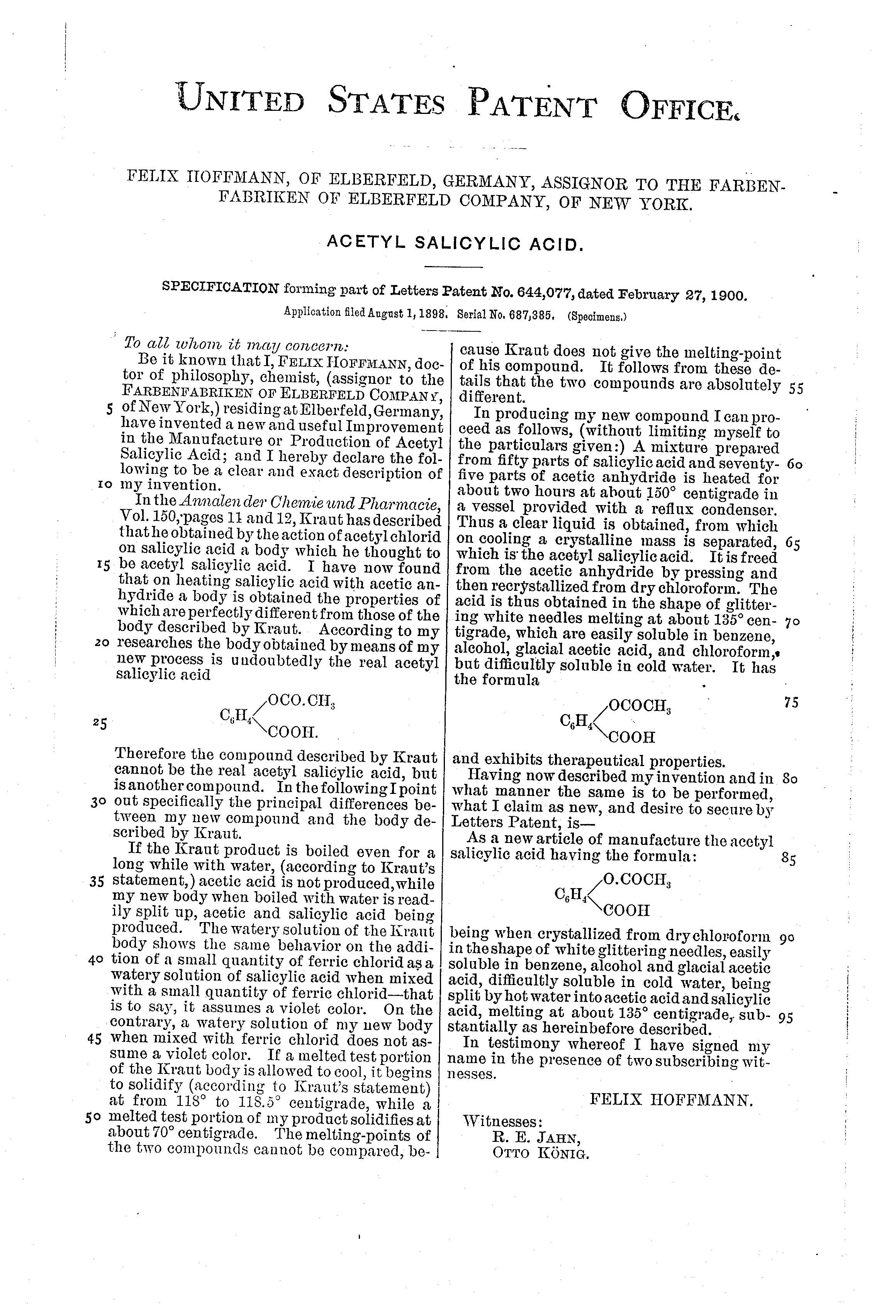
Suiter Swantz IP is a full-service intellectual property law firm, based in Omaha, NE, serving all of Nebraska, Iowa, and South Dakota. If you have any intellectual property questions or need assistance with any patent, trademark, or copyright matters and would like to speak to one of our attorneys please contact us.
Patent of the Week: Cardiac Pulse-Rate Monitor
On October 21, 1969, Albert Dale Herman and Herbert Zeppo Marx were granted the patent for Cardiac Pulse-Rate Monitor U.S. Patent No. 3,473,526.
According to the patent application this unit, worn on the wrist, was designed to “provide an audible and vibratory warning to advise persons who have cardiac impairment, of extreme variations in the pulse rate.”
This invention was ahead of its time in its defense to aid those with cardiac impairments. Now we are in an era of FitBist® and other smart watches and fitness trackers that can monitor not just your vitals, but your steps, sleep habits, caloric intake/output, etc.
Herbert Zeppo Marx, the youngest of the famous comedic Marx brothers, is one of the inventors of this monitor. Many do not know that in addition to being a comedian Zeppo was also a business man, engineer, and inventor with more than one patent.
Zeppo was also the founder of Marman Products, which manufactured clamping devices and motorcycles. The clamping devices were used to secure “Fat Man” atomic bombs being transported to Enola Gay in World War II.
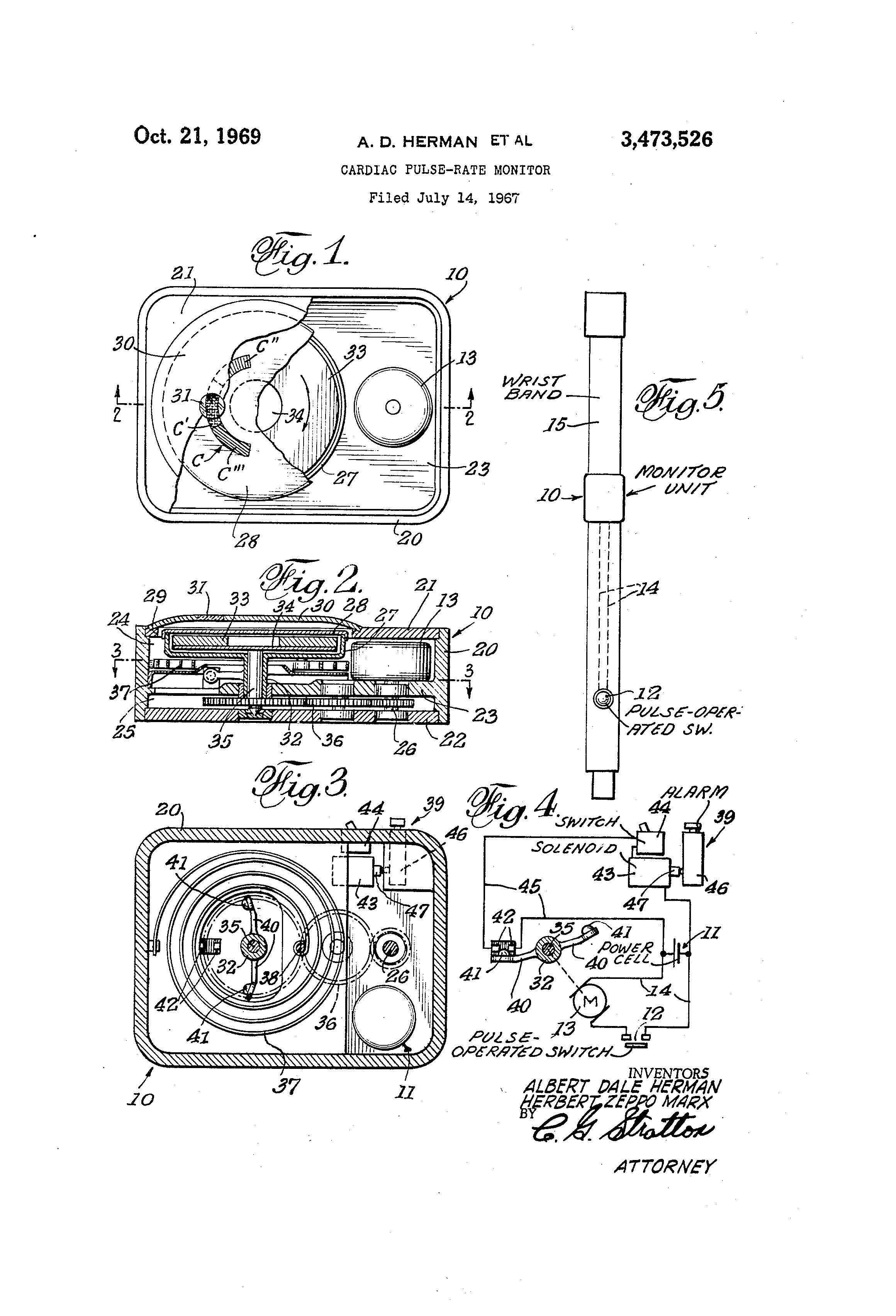
Suiter Swantz IP is a full-service intellectual property law firm, based in Omaha, NE, serving all of Nebraska, Iowa, and South Dakota. If you have any intellectual property questions or need assistance with any patent, trademark, or copyright matters and would like to speak with one of our patent attorneys please contact us.
Office Hours March 15 at the Brookings, SD Office
Suiter Swantz IP will be holding office hours at our Brookings, SD satellite office located in the South Dakota State Research Park on March 15th.
Feel free to send Matt Poulsen an email (map@suiter.com) if you’d like to reserve a time to meet or have any questions.
Suiter Swantz IP
402-496-0300
www.suiter.com
Welcome New Hire Faisal K. Abou-Nasr
Suiter Swantz IP is very excited to announce that Faisal Abou-Nasr has joined the Firm as a patent attorney. Faisal’s legal and technical depth will enhance the Firm’s ability to carry out its mission, which is to provide only the highest quality of patent legal services to our clients. Faisal holds a bachelor’s degree in electrical engineering from the University of Nebraska – Lincoln and a law degree from Creighton University.
Faisal’s practice focuses on patent procurement, with a focus on the preparation and prosecution of patent applications related to computer hardware and software, networking and storage solutions, digital advertising, data aggregation and analysis, cybersecurity, telecommunications, avionics, navigation systems, mobile devices, downhole drilling and measurement tools, optical metrology, and medical instruments.
Chad Swantz to Discuss Intellectual Property Issues Relevant to Craft Brewers
Chad Swantz of Suiter Swantz IP has been invited to discuss intellectual property issues relevant to craft brewers at the 2018 Legally Brewed Conference. The conference will be hosted by Woods & Aitken LLP on Wednesday, March 14, 2018, at the Lincoln Marriot Cornhusker Hotel.
If interested in attending please register here.
Triumph of Agriculture Expo Feb 28 - March 1
Several Suiter Swantz IP attorneys will be in attendance at the 2018 Triumph of Agriculture Expo, the Midwest's largest indoor shortline farm show. The events will take place Wednesday, February 28th and Thursday, March 1st at the CenturyLink Center. Be sure to stop by and visit our booth.
Matt Poulsen of Suiter Swantz IP will discuss “Protecting your Innovation” in seminar room 1, inside the CenturyLink Center, at 10:00 am on Wednesday February 28th.
For more information click here.
African American Innovators Throughout History
February is Black History Month and all of us at Suiter Swantz IP wanted to take this opportunity to take a look at some of the African American inventors, innovators, and scientists who have helped shape innovation and the U.S. patent system.
The modern United States patent system has been in existence for well over two hundred years. The very first U.S. patent was granted in 1790, at a time in which slavery was very much alive. During this bleak and loathsome time period of American history, African Americans born into slavery were not considered U.S. citizens, and were forbidden by law from applying for or holding property. As a form of intellectual property, this included patents. This seemingly blanket prohibition on slave-owned property was affirmed by the U.S. Commissioner for Patents in 1857, when it was officially ruled that inventions by slaves could not be patented.
Although the law of the land could prevent slaves from owning patents, the law could not, and did not, stop them from inventing and innovating.
Henry Boyd
Henry Boyd was born into slavery in 1802. From a young age, Boyd knew he wanted to be a carpenter. He learned the trade early in life and quickly became skilled in the craft. Through his craftsmanship, Boyd was able to earn a substantial amount of money, which he used to purchase his freedom in 1826. As a newly-freed man, Boyd moved to Cincinnati where he continued his career as a carpenter building homes. His skill and expertise as a carpenter allowed him to purchase the freedom of his sister 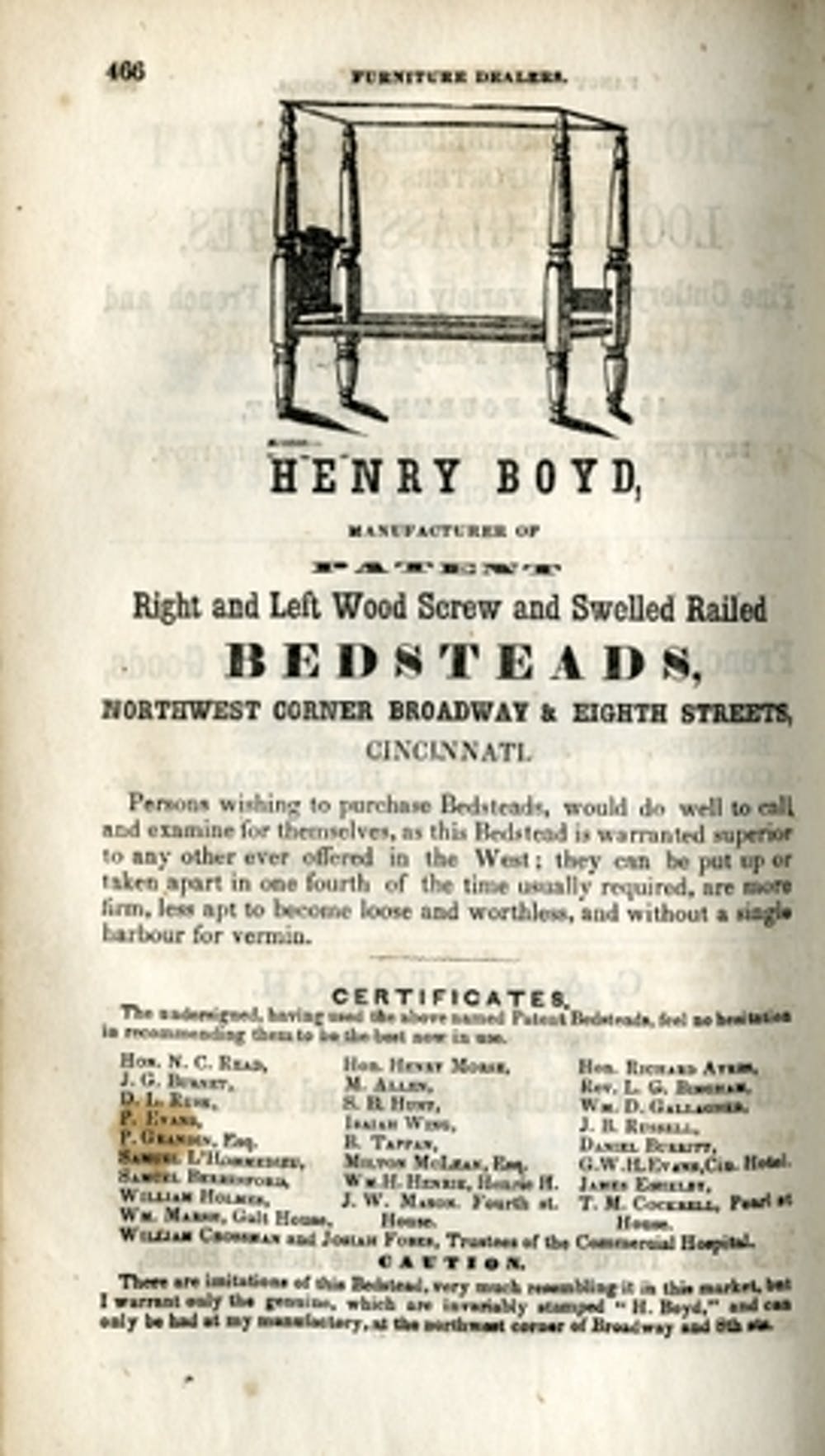 and brother. At the age of 34, Boyd started his own company which specialized in making bed frames. As a product of this new venture, Boyd invented the “The Boyd Bedstead,” a bed constructed of wooden rails that connected the headboard and footboard together. This new construction provided increased durability and stability, and is still widely used today.
and brother. At the age of 34, Boyd started his own company which specialized in making bed frames. As a product of this new venture, Boyd invented the “The Boyd Bedstead,” a bed constructed of wooden rails that connected the headboard and footboard together. This new construction provided increased durability and stability, and is still widely used today.
As a freed man, Boyd attempted to patent his invention. Even as a freed man, the Patent Office denied his application. Undeterred, Boyd partnered with a Caucasian craftsman, George Porter. Under this arrangement, Porter applied for a patent on the Boyd Bedstead, and was granted the patent on December 30, 1833 (U.S. Patent No. X7911). Although the patent was not in Boyd’s name on paper, that did not stop him from making the beds and stamping his name on each and every of them.
Thomas Jennings
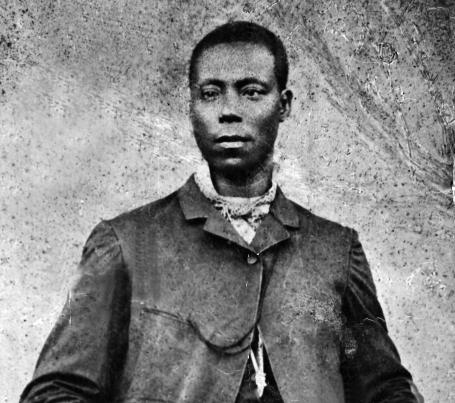 Born in 1791 as a free African American in New York City, Thomas Jennings began his career as a tailor and dry-cleaner. Jennings was so skilled people came from all over to receive custom-tailors and alterations. His skill and reputation allowed him to eventually open a tailoring and dry-cleaning shop on Church Street, which became one of the largest clothing stores in New York City. In 1820, Jennings invented a process called dry-scouring, a process similar to that of modern-day dry-cleaning. He was granted a patent on the dry-scouring process on March 3, 1821 (U.S. Patent No. X3,306), making him the first African American to receive a patent.
Born in 1791 as a free African American in New York City, Thomas Jennings began his career as a tailor and dry-cleaner. Jennings was so skilled people came from all over to receive custom-tailors and alterations. His skill and reputation allowed him to eventually open a tailoring and dry-cleaning shop on Church Street, which became one of the largest clothing stores in New York City. In 1820, Jennings invented a process called dry-scouring, a process similar to that of modern-day dry-cleaning. He was granted a patent on the dry-scouring process on March 3, 1821 (U.S. Patent No. X3,306), making him the first African American to receive a patent.
In addition to being known as the first African American to receive a patent, Jennings is also remembered as a civil rights activist and for his extensive work with the abolitionist movement. In 1831, Jennings became the assistant secretary for the First Annual Convention of the People of Color in Philadelphia.
George Washington Carver
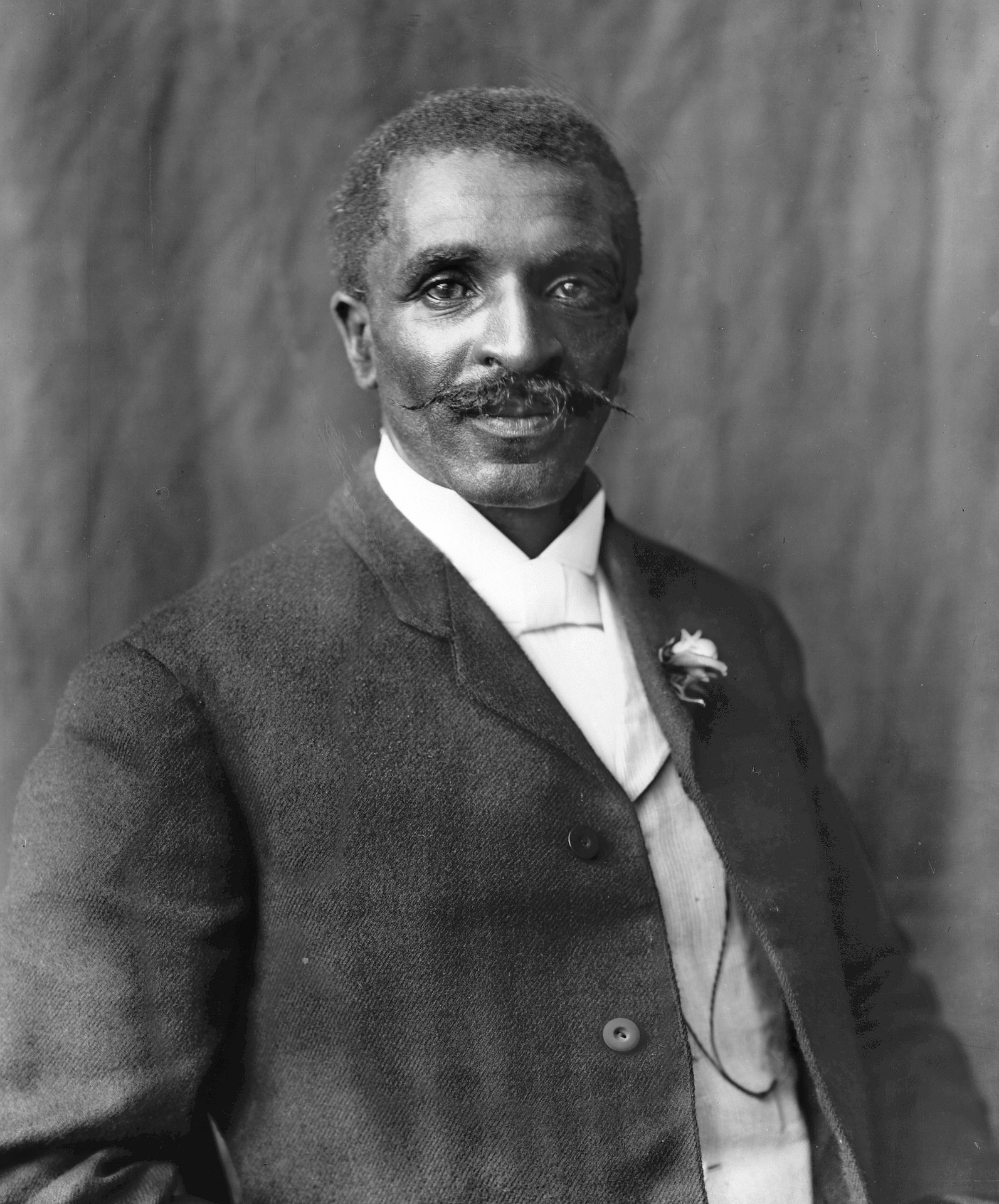 George Washington Carver was born into slavery in 1864. Following the abolition of slavery, Carver’s former owners, Moses and Susan Carver, raised Carver as one of their own, teaching him how to read and write. In addition to helping out with daily chores, Carver would observe “Aunt Susan” make herbal medicines. This sparked an interest in Carver that he would maintain throughout the rest of his life. Carver began to experiment with plants, pesticides, soil conditions, etc., and became known as the “plant doctor,” helping neighboring farmers improve their crops and fields.
George Washington Carver was born into slavery in 1864. Following the abolition of slavery, Carver’s former owners, Moses and Susan Carver, raised Carver as one of their own, teaching him how to read and write. In addition to helping out with daily chores, Carver would observe “Aunt Susan” make herbal medicines. This sparked an interest in Carver that he would maintain throughout the rest of his life. Carver began to experiment with plants, pesticides, soil conditions, etc., and became known as the “plant doctor,” helping neighboring farmers improve their crops and fields.
As an African American, it was not easy for Carver to earn a formal education. After much searching, he was able to attend the School for African American Children in Neosho, Kansas, which was a 10 mile walk from Carver’s home. At the age of thirteen, Carver left home to continue his high school education. Following high school, Carver received a scholarship to attend Highland Presbyterian College in Kansas. The scholarship was short lived, however, as the school turned him away on the first day of school upon learning that he was black.
Despite this setback, Carver was accepted into Simpson College in Indianola, Iowa, in 1888, making him the first black student to attend the school. Carver’s interest in botany led him to Iowa State Agriculture School (now Iowa State University) where he earned his Bachelor of Science degree in 1894. The school was so impressed with his work they asked him to stay on as faculty while earning his Master’s degree, which he obtained in 1896.
Through his interest and research in botany, Carver was granted two patents in 1925 and 1927, entitled COSMETIC AND PROCESS OF PRODUCING THE SAME (U.S. Patent No. 1,522,176) and PROCESS OF PRODUCING PAINTS AND STAINS (U.S. Patent No. 1,632,365). In 1990, Carver was the first African American inducted into the National Inventors Hall of Fame. As a successful scientist, Carver invented countless methods and products which could have been patented, yet Carver only patented three of these inventions. When asked why he hadn’t patented more of his inventions, he stated: “[If] I did it would take so much time, I would get nothing else done. But mainly I don't want my discoveries to benefit specific favored persons.”
Rebecca Cole
Born in Philadelphia in 1846, Rebecca Cole attended the prestigious Institute for Colored Youth. With an eye towards training black youth to become teachers and scholars, the school boasted an intense curriculum that included Greek, Latin, and Mathematics. Cole excelled in school and graduated in 1863.
Cole went on to become the second African American woman to receive a Master’s degree in the United States. Following graduation, Cole attended medical school at the Female Medical College of Pennsylvania. Cole graduated in 1867, and was the first African American woman to obtain her M.D. from the school. As a med school graduate, Cole moved to New York City and began work at the Infirmary for Women and Children, one of the earliest programs for medical social services. She became a social activist and worked as the superintendent of the Home for Destitute Colored Women and Children in Washington D.C. Although there is little information about Cole outside of her work in the medical field, her passion for providing health care to impoverished women and children paved the way for women, and African American women especially, to pursue careers in science and medicine.
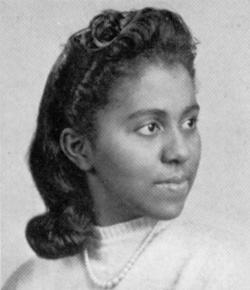 One woman who followed down a similar path as Cole was Marie M. Daly (pictured left). Daly is best known as being the first African American woman to receive her Ph.D. in chemistry. Betty W. Harris also exceled in the chemical field and received her Ph.D. in chemistry. Harris was intrigued by explosives and became a noted expert in the field. She went on to patent SPOT TEST FOR 1,3,5-TRIAMINO-2,4,6-TRINITROBENZENE TATB (U.S. Patent No. 4,618,452).
One woman who followed down a similar path as Cole was Marie M. Daly (pictured left). Daly is best known as being the first African American woman to receive her Ph.D. in chemistry. Betty W. Harris also exceled in the chemical field and received her Ph.D. in chemistry. Harris was intrigued by explosives and became a noted expert in the field. She went on to patent SPOT TEST FOR 1,3,5-TRIAMINO-2,4,6-TRINITROBENZENE TATB (U.S. Patent No. 4,618,452).
Dr. Patricia Bath (pictured right) is known as becoming one of the first African American women to receive a medical patent. She was granted the 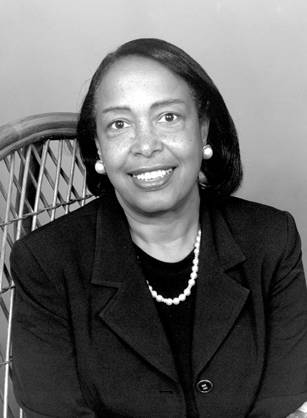 patent for APPARATUS FOR ABLATING AND REMOVING CATARACT LENSES in 1988 (U.S. Patent No. 4,744,360). Bath was also the first African American to complete a residency in ophthalmology, and also the first woman faculty member in the department of Ophthalmology at UCLA’s Jules Stein Eye Institute. Her love of ophthalmology led her to co-found the American Institute for the Prevention of Blindness.
patent for APPARATUS FOR ABLATING AND REMOVING CATARACT LENSES in 1988 (U.S. Patent No. 4,744,360). Bath was also the first African American to complete a residency in ophthalmology, and also the first woman faculty member in the department of Ophthalmology at UCLA’s Jules Stein Eye Institute. Her love of ophthalmology led her to co-found the American Institute for the Prevention of Blindness.
African Americans have played a vital role in shaping innovation in this country. The effects of these and numerous other African American inventors can be felt every single day in the United States and around the world.
Suiter Swantz IP is a full-service intellectual property law firm, based in Omaha, NE, serving all of Nebraska, Iowa, and South Dakota. If you have any intellectual property questions or need assistance with any patent, trademark, or copyright matters and would like to speak to one of our attorneys please contact us.

